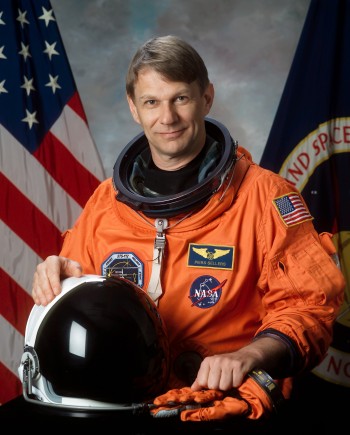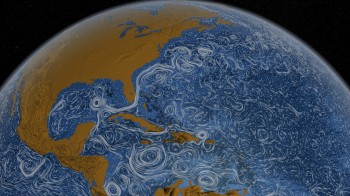Piers Sellers: a Revolution in Earth Science
November 2, 2015

Astronaut and NASA researcher Piers Sellers gave a digital tour of the Earth’s biosphere in a February 2015 talk at the Jackson School of Geosciences that highlighted the causes and effects of climate change.
In his talk, Sellers, who is deputy director of the Sciences and Exploration Directorate at NASA’s Goddard Space Flight Center, used computer graphics generated from satellite data to illustrate an array of phenomena happening on planet Earth, from the winding flow of ocean currents to electric nodes of cities seen from space.
“It’s a revolution in Earth science, an absolute revolution,” Sellers said after explaining the many parameters that satellites constantly monitor as they orbit the globe.
The topics he focused the most on were the state of the planet’s ice sheets and atmospheric CO2 concentration.

The Arctic ice sheet has undergone dramatic change over the past 30 years, Sellers illustrated using a graph and model. The multiyear ice is almost all gone, and the area of the ice sheet has shrunk by half since 1979.
“If you believe the models, it means in 30 years you’ll be able to kayak over the top of the world…over an ice-free ocean,” Sellers said. “It’s quite a remarkable change here.”
The reason for the extreme and rapid loss is complex, Sellers said, with factors as varied as winds pushing ice, and the self-catalyzing albedo effect — a process where dark ocean water absorbs heat, melts ice, and perpetuates the process by revealing more water.
“It is not a straightforward problem. It’s not just heat in, melt out,” Sellers said. “There’s other stuff going on.”
However, based on measurements from scientific instruments, from LIDAR deployed on planes and monitoring devices on satellites, the net state of ice on the planet is in decline, Sellers said. And although the Arctic is experiencing the most dramatic decline, the ice sheets of Antarctica and Greenland are also experiencing changes. In both regions, the rate glaciers are moving toward the sea is accelerating, with Greenland’s rate doubling in speed since first being recorded 20 years ago.
While sea ice is decreasing, carbon dioxide is on the rise, Sellers said.
Using a graphic indicating atmospheric carbon dioxide concentration from 2004-2014, Sellers showed how the concentration of carbon in the atmosphere is increasing overall, while still cyclically rising and falling as carbon is released by industry, volcanoes and fires, and absorbed by oceans and plants. A progressively thickening band of CO2 across the northern hemisphere is the result of industry activity, Sellers said.
“There is a constant gradient between the northern hemisphere and the southern hemisphere because all the release is up there,” Sellers said.
Years of data combined with mechanistic knowledge have enabled models of the whole planet accurate enough to save lives by predicting the paths of storms, such as Hurricane Sandy in 2013, Sellers said. However, in the long term they paint a bleak picture of global temperature rising with CO2 levels.
The models are reliable at predicting the impacts of a 4-degree temperature increase. After 4 degrees is when things become uncertain for the models, as well as the planet, Sellers said.
“When we get into a 4-degree world it’s rough. It may be a different kind of planet,” Sellers said.
Despite the model projections, Sellers said he believes it’s possible to turn the future around.
“We have an example that should give us a course for optimism,” he said. “The ozone hole.”
Through an international effort started when the hole was first detected in the 1980s, humans have been able to halt the hole’s widening, and create an environment where the ozone layer may be able to recover to its baseline state, Sellers explained.
“It was policy that was advised by scientific data and predictions that gave a good example of a happy ending.”
Sellers said that he has similar hopes for humanity when it comes to tackling climate change.
“Every person who arrives on the Earth not only comes with their own demands, but their own talents and creativity and what they want to contribute,” Sellers said. “And so the people who arrive are going to be part of the solution to get us out of trouble, and that includes all of you younger people here.”
— Monica Kortsha
Back to the Newsletter